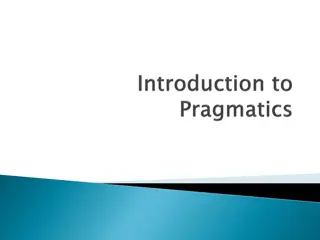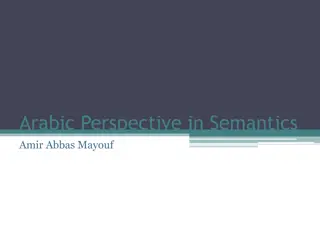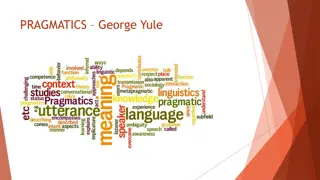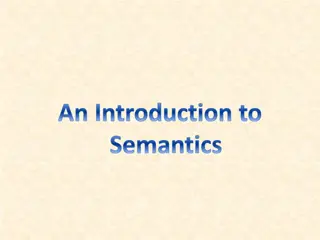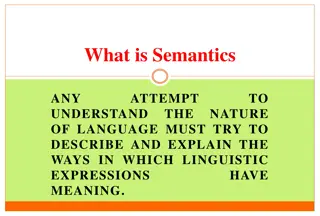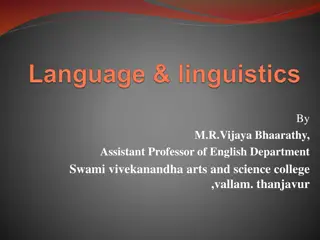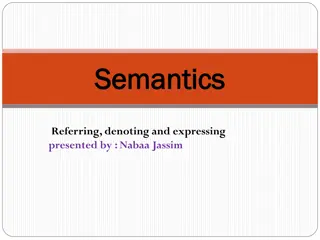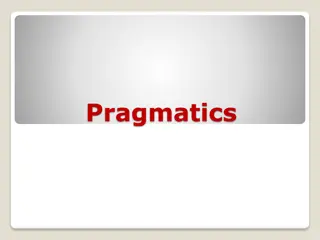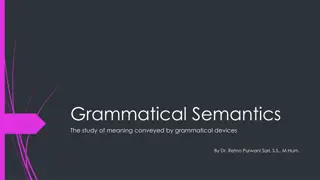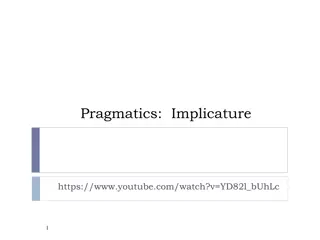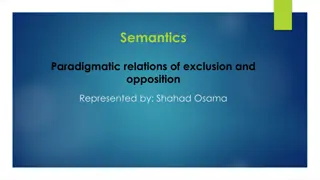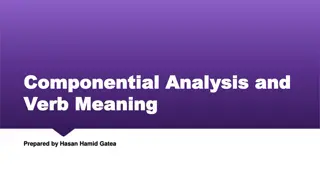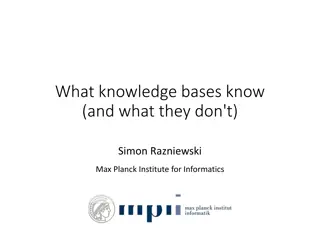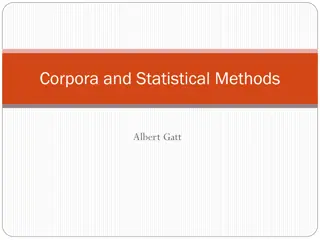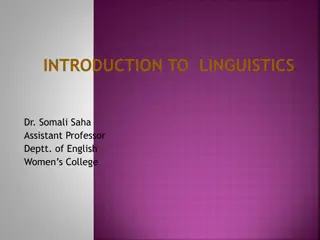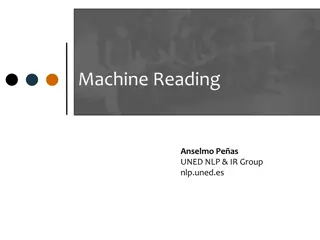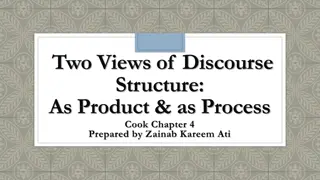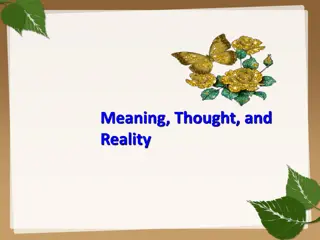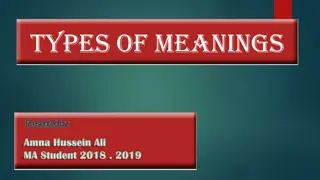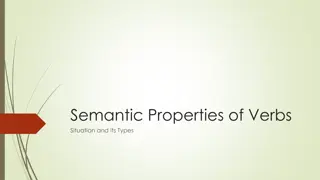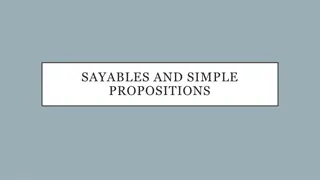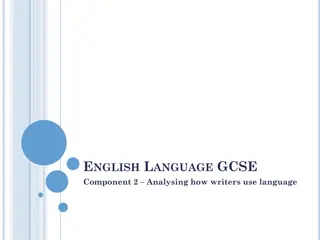Understanding Semantics and Pragmatics in Language Study
Semantics and pragmatics are key areas of language study that focus on the meanings of words, phrases, and sentences. Semantics delves into the literal meanings and language as a system, while pragmatics explores how speakers use language in context. Understanding semantic meaning involves considering the context, word meanings, and sentence structure. Sense and reference play crucial roles in distinguishing linguistic knowledge and acts of reference. The content highlights essential concepts like compositionality, thematic roles, and figurative language use in semantics and the integration of contextual knowledge in pragmatics.
Download Presentation

Please find below an Image/Link to download the presentation.
The content on the website is provided AS IS for your information and personal use only. It may not be sold, licensed, or shared on other websites without obtaining consent from the author. Download presentation by click this link. If you encounter any issues during the download, it is possible that the publisher has removed the file from their server.
E N D
Presentation Transcript
Definitions: semantics and pragmatics Sense and reference Lexical semantics: Fundamental semantic relations Compositionality Componential analysis Thematic roles Tense and Modality Figurative uses of language
Semantics the study of meaning in language Pragmatics studies how speakers integrate contextual and non-linguistic knowledge in the communication of meaning Semantics concerned with language as a system Pragmatics concerned with how speakers use language
Focuses on the literal meanings of words, phrases and sentences; concerned with how grammatical processes build complex meanings out of simpler ones
To understand semantic meaning, we have to bring together 3 main components: 1) the context in which a sentence is used, 2) the meanings of the words in the sentence, 3) the morphological and syntactic structure
Sense meaning without reference to the specific real object in the world (e.g. house dwelling ) Reference is meaning tied to a specific instance (e.g. the red house and the house at the end of the block do not have the same meaning in terms of sense, but they could refer to the same house)
Reference: the act of using language to identify or pick out individuals Sense: the linguistic knowledge which allows the act of reference
Sense: President of the USA Reference (2017): Trump Reference: I ate a banana for breakfast this morning. Sense: A banana is a type of fruit.
Any banana is a kind of fruit denotation class of entities to which an expression may apply is its extension denotation; the extension. I m looking for a cat either a particular cat or looking to select from a set of cats. Listeners would have to infer which was meant in a particular context.
Denotation the relationship between words and the world that makes reference possible The person or thing identified by uttering a noun phrase or name is called the referent The class of entities to which an expression may be applied is called its extension Sentences are abstractons from utterances While sentences have meaning, their full interpretation only emerges when they are uttered in context
Some argue that proper names have only reference and no sense. Do you agree?
It is possible that proper nouns have reference but no sense, like Spain. There are also noun phrases that have sense but no reference, e.g. The present king of France is bald.
1. A 2. 3. No 4. mermaid 5. A police for a one A seagull 2. I don t like living in a a city 3. No politician 4. The mermaid. . 5. A police spokesman a one- -armed seagull just stole my my sandwich city. . sandwich. . politician is completely honest. The dugong dugong doesn t look anything like a a spokesman said they are looking armed man man. .
The study of word meaning The basic aims: 1) to represent the meaning of each word in the language 2) to show how the meanings of words in a language are interrelated Morphemes the minimal units of meaning which make up words and larger units
Our lexicon a collection of lexemes with 1) a representation of its meaning and 2) representation of its meaning relations with other lexemes
The most fundamental lexical relations describe how words, phrases, and sentences relate to each other and to the world
Words which are pronounced ad possibly spelled in the same way (homographs), but with different meanings, e.g. to, too, two; bat (animal), bat (stick)
A) Different category, same pronunciation, same spelling (bear) A and B: homonyms B) same category, same pronunciation, different spelling (pair and pear) C) different category, same pronunciation, different spelling, (to and two): homophones D) same category, different pronunciation, same spelling (row line and row quarrel): homographs E) different category, differet pronunciation, same spelling (v. lead and noun lead (denoting the metal) homonyms homophones homographs
A word is polysemous if it has more than one closely related meaning (e.g. wood a piece of a tree , a group of trees ) In a dictionary, polysemous words are often listed as one head word, with several different senses (e.g. bear: 2 entries: 1.a to move while holding up and supporting ; 2. to give birth to , 3. to suport the weight of ; 1.b to hold in the mind ; bear n. a big shaggy animal
It is often difficult to distinguish vagueness from polysemy Polysemous words have multiple different, but related, meanings; vagueness, in contrast, describes a single general meaning which becomes more specific in a particular context of use Since it involves more than one meaning, polysemy is a kind of ambiguity, but vagueness is not
Synonymous words have (more or less) the same meaning: (answer reply) Some linguists argue that no two words have exactly the same meaning, as they may differ in connotation (e.g. slender, slim, skinny) or in their typical contexts of use (e.g. buy, purchase)
Note down the synonyms of your classmates. For each decide whether they are exact synonyms, i.e. whether they can easily be substituted for each other
Antonyms words that are closely related; they have properties in common, such as grammatical class and lexical field, but they oppose each other in one aspect of meaning
1. complementary implies the absence of the other, e.g. alive/dead, present/absent 2. gradable short/long 3. relational implies the existence of its converse, e.g. buyer/seller, husband/wife. complementary when the presence of one gradable: e.g. rich/poor, happy/sad, relational opposites opposites: the existence of one
A relation of inclusion between more specific and less specific terms: poodle, boxer, bulldog, schnauzer hyponyms of dog (hyperonym) These relations can have several levels, so dog is a hyponym of a mammal, which is a hyponym of animal
These networks conceptual and cultural rather than natural since words can be in several networks (dog is a hyponym of pet, where its co-hyponyms may be cat, turtle, hamster, etc.) These hierarchical networks in the lexicon of a language of great interest in anthropology and psychology since they reflect the conceptual classifications of the world embedded in particular languages
For each of the categories below, provide examples: 1. synonymy 2. polysemy 3. homonymy 4. hyponymy
Lexical semantics the study of word meaning and meaninng relations between words in the vocabulary The store of knowledge about a language s words the lexicon The semantic unit at word level the lexeme Meaning relations in the lexicon: homonymy, polysemy, antonymy, hyponymy The meaning of a word is usually equated with a concept, with no common agreement about how this is structured
Grammar (morphology and syntax) generates new words, phrases and sentences This gives us a potentially infinite number of words, phrases and sentences that can have meaning In order to explain how an infinite number of pieces of language can be meaningful, and how we, as language users, can figure out the meanings of new ones, semanticists apply the Principle of Compositionality
The semantic meaning of any unit of language is determined by the semantic meanings of its parts along with the way they are put together
Mary liked you the meaning is determined by (a) the meanings of the individual morphemes that make it up (Mary, like, past , you) B) the morphological and syntactic structures of the sentence
Compositional semantics (or formal semantics) concerned how the Principle of Compositionality applies Formal semanticists study the variety of grammatical patterns which occur in individual languages and across the languages of the world
The semantic information contained in the lexicon is represented in terms of semantic features, which are arrived at through componential analysis Breaks down the lexical item into its smaller semantic components, which are then listed through feature notation, which includes the semantic and phonological features
The entry for boy has the syntactic features: (+Noun), (+Count), (+Common) and it consists of semantic features such as (+) human, which subsumes other semantic features such as (+Animate) Boy +HUMAN ADULT +MALE Girl +HUMAN ADULT MALE Man +HUMAN + ADULT +MALE Woman +HUMAN +ADULT -MALE
The categorial rules generate a string of slots to be filled with items from the lexicon via lexical insertion rules. Each slot - associated with a set of features which indicate which kind of item can be filled in By combining these features with those features in the lexicon, the lexical insertion rules generate such sentences as The boy laughed, but not such sentences as The chalk lauged.
Speakers combine words into phrases and sentences, and sentences allow us to describe the world in different ways Construal - the particular view-point that a speaker chooses when describing something Every language offers its speakers a range of ways to classify situations and events, and to describe the roles of the people and objects involved
Situations: static and dynamic Static situations relating individuals to locations, or attributing them qualities (The book is in the library; She s a doctor) Dynamic situations identification of change; can be viewed as processes or events, or actions States described by adjectives Dynamic situations described by verbs
Distinctions of situation types involve different ways of viewing time The linguistic aspects: aspect and tense Aspect allows different views of how a situation is distributed over time, while tense allows the positioning of situations in time relative to some reference point
Lexical and grammatical Lexical apect: situation type (durative situations spread over time, and punctual, which describes sth taking place instantaneously
When sentences are constructed, lexical aspect combines with grammatical aspect Grammatical aspect marked by morphology and the use of specific auxiliaries (perfective/imperfective: a) John built a house, b) John was building a house) Aspect- inextricably linked to tense Tense anchored relative to the current act of speaking or writing
Epistemic that we know (I must have left my keys in the car) Deontic keys in the car); Modals which are about rules, right and wrong, obligations etc. are known as deontic modals Epistemic modals modals involve reference to facts Deontic modals modals (Guests should leave their
Possible worlds help explain the semantics of modals because they provide a way of talking about alternative possibilities The ability to imagine alternative ways that the world could be alternative possible worlds an essential part of the human capacity to use language
Another range of semantic options allows the speaker to characterize the roles of various entities in a situation There are certain semantic roles available to a speaker, which can be associated with verbs
Agent with volition Patient action, typically undergoing a change of state Theme action, or whose location is described Experiencer state described by the predicate but not in control of it Beneficiary action Agent: initiator of action, capable of acting Patient: entity undergoing the effect of some Theme: the entity which is moved by an Experiencer: an entity aware of the action or Beneficiary: the entity benefiting from an
Instrument causes sth to come about Location takes place Goal Source Stimulus experiencer Instrument: the means by which an agent Location: the place in which sth is situated or Goal: the entity towards which sth moves Source: the entity from which sth moves Stimulus: the entity causing an effect in the experiencer
Semantic roles which noun phrases play in relationship to the verb of the clause Verb has the central role in the clause, and it assigns roles to participants depending on the type of the predicate (e.g.The boy kicked the ball) The boy doer of the action: agent The ball the receiver of the action and is changed by it: the theme kicked agent theme
A rock star (agent) threw the television (theme) from the window (source) The takeoff (stimulus) frightened the passangers (experiencer) The conspirators (agent) assasinated Julius Caesar (patient) with daggers (instrument)
Reason for identifying these roles the insight they provide into the lexical semantics of verbs Representing semantic roles can help capture facts about verb classes and argument structure possibilities
A) Kill: agent, patient, instrument Doctors killed the virus with a mystery drug. A mystery drug killed the virus. B) assasinate: agent, patient, instrument The anarchist assassinated the emperor with a bomb. *The bomb assassinated the emperor.


